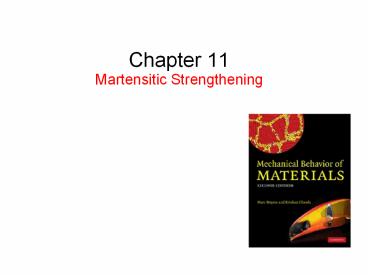Chapter 11 Martensitic Strengthening - PowerPoint PPT Presentation
Title:
Chapter 11 Martensitic Strengthening
Description:
Chapter 11 Martensitic Strengthening * * * * * * * * * * * * * * * * * * * * Systems that Show Martensitic Transformations Free energy versus temperature for ... – PowerPoint PPT presentation
Number of Views:334
Avg rating:3.0/5.0
Title: Chapter 11 Martensitic Strengthening
1
Chapter 11Martensitic Strengthening
2
Systems that Show Martensitic Transformations
3
Free Energy vs. Temperature for Austenite and
Martensite
Free energy versus temperature for austenite
(parent phase) and martensite.
4
Morphologies of Martensite
(a) Lenticular martensite in an Fe30 Ni alloy.
(Courtesy of J. R. C. Guimarães.)? (b) Lenticular
(thermoelastic)? martensite in CuAlNi alloy.
(Courtesy of R. J. Salzbrenner.)?
5
Lath Martensite
Lath martensite. (Reprinted with permission from
C. A. Apple, R. N. Caron, and G. Krauss, Met.
Trans., 5 (1974)? 593.)?
6
Twinned and Dislocated Martensites
Fracture toughness vs. yield strength for twinned
and dislocated martensites in a medium-carbon
(0.3 C) steel. (Courtesy of G. Thomas.)?
7
Acicular Martensite
Acicular martensite in stainless steel forming at
intersection of slip bands.(Courtesy of G. A.
Stone.)?
8
Twins Inside Martensite
(a) Transmission electron micrograph showing a
group of twins inside martensite transformed at
140 ?C and 2 GPa. (b) Dark-field image of twins
on (112)b plane (c)? Stereographic analysis for
habit (in FCC) and twin (in BCC) planes. (From S.
N. Chang and M. A. Meyers, Acta Met., 36 (1988)
1085.)?
9
Twins within Martensite Lenses
Martensite lenses (M)? being traversed by twins,
which produce self accommodation. (Courtesy of A.
R. Romig.)?
10
Strength of Martensite
0.6 proof stress (one-half of tensile stress)?
vs. (carbon concentration)0.5 for FeNiC lath
martensite at various temperatures. The slopes
are shown as fractions of the shear modulus, G.
(Adapted with permission from M. J. Roberts and
W. J. Owen, J. Iron Steel Inst., 206 (1968) 37.)?
11
Strength of Martensite
Effect of prior austenite grain size on the yield
stress of three commercial martensitic steels.
(Adapted with permission from R. A. Grange,
Trans. ASM, 59 (1966) 26.)?
12
Distortion Produced by Martensite Lens
Distortion produced by martensite lens on a
fiducial mark on surface of specimen.
13
Martensite Start Temperature as Function of
Loading Condition
Change in Ms temperature as a function of loading
condition. (Adapted with permission from J. R.
Patel and M. Cohen, Acta Met., 1 (1953)? 531.)?
14
Mechanical Effects
Temperature dependence of the yield strength of
Fe31 Ni0.1 C. , predeformed by shock
loading. (Adapted with permission from J. R. C.
Guimarães, J. C. Gomes, and M. A. Meyers, Supp.
Trans. Japan Inst. of Metals, 17 (1976) 41.)?
Tensile curves for FeNiC alloy above Ms,
showing martensite forming in elastic range
(stress assisted). (Courtesy of J. R. C.
Guimarães.)?
15
Strain-induced Martensite
Volume fraction transformed (right-hand side), f,
and stress (left-hand side) as a function of
plastic strain for an austenitic (metastable)
steel deformed at 50 ?C experimental and
idealized stressstrain curves for austenite,
martensite, and mixture are shown. (After R. G.
Stringfellow, D. M. Parks, and G. B. Olson, Acta
Met., 40 (1992) 1703.)?
16
Microcracks in Martensite
Microcracks generated by martensite. (a) Fe8
Cr1 C (225 martensite sectioned parallel to
habit plane). (Courtesy of J. S. Bowles,
University of South Wales.)? (b) Carburized
steel. (Reprinted with permission from C. A.
Apple and G. Krauss, Met. Trans., 4(1973) 1195.)?
17
Shape Memory Effect
(a) Pseudoelastic stressstrain curve for a
single-crystal CuAlNi, alloy at 24 ?C (72 ?C
above Ms). (b) Dependence on temperature of
stressstrain characteristics along the
characteristic transformation temperatures.
Strain rate 2.5 10-3 min-1. (Reprinted with
permission from C. Rodriguez and L. C. Brown, in
Shape Memory Effects, (New York Plenum Press,
1975), p. 29.)?
18
Pseudoelastic Effect
Schematic representation of pseudoelastic (or
superelastic) effect. (a) Initial specimen with
length L0. (b, c, d)? Formation of martensite and
growth by glissile motion of interfaces under
increasing compressive loading. (e) Unloadingof
specimen with decreasing martensite. (f) Final
unloaded configuration with length L0. (g)
Corresponding stressstrain curve with different
stages indicated.
19
Strain Memory Effect
Sequence showing how growth of one martensite
variant and shrinkage of others results in strain
eL. (Courtesy of R. Vandermeer.)?
20
Strain-Memory Effect in Compression
Schematic representation of strain-memory effect
in compression, tension, and bending. Variant A
favors a decrease in dimension in the direction
of its length, whereas variant B favors an
increase in dimension.
21
Strain-Memory Effect
Schematic representation of strain-memory effect.
(a) Initial specimen with length L0 . (b, c, d)
Formation of martensite and growth by glissile
motion of interfaces under increasing compressive
stresses. (e) Unloading of specimen. (f) Heating
of specimen with reverse transformation. (g)
Corresponding stressstrain curve with different
stages indicated.
22
Martensitic Transformation in Ceramics
(a) Lenticular tetragonal zirconia precipitates
in cubic zirconia (PSZ). (b) Equiaxial ZrO2
particles (bright) dispersed in alumina (ZTA).
(Courtesy of A. H. Heuer.)?
23
Martensite in Cubic Zirconia
Atomic-resolution transmission electron
micrograph showing extremity of tetragonal lens
in cubic zirconia notice the coherency of
boundary. (Courtesy of A. H. Heuer).
24
Zirconia Phase Diagram
ZrO2-rich portion of ZrO2MgO phase diagram.
Notice the three crystal structures of ZrO2
cubic, monoclinic, and tetragonal.
25
Martensite in Zirconia
TEM of martensitic monoclinic lenses in ZrO2
stabilized with 4 wt Y2O3 and rapidly
solidified the zigzag pattern of lenses is due
to autocatalysis. (Courtesy of B. A. Bender and
R. P. Ingel.)?
26
Zirconia-Toughened Alumina
(a) Zirconia-toughened alumina (ZTA) traversed by
a crack. Black regions represent monoclinic
(transformed) zirconia, gray regions tetragonal
(untransformed) zirconia. (b) Partially
stabilized zirconia (PSZ). Lenticular
precipitates transformed from tetragonal to
monoclinic in the vicinity of a crack. Notice the
brighter transformed precipitates. (Courtesy of
A. H. Heuer.)?































